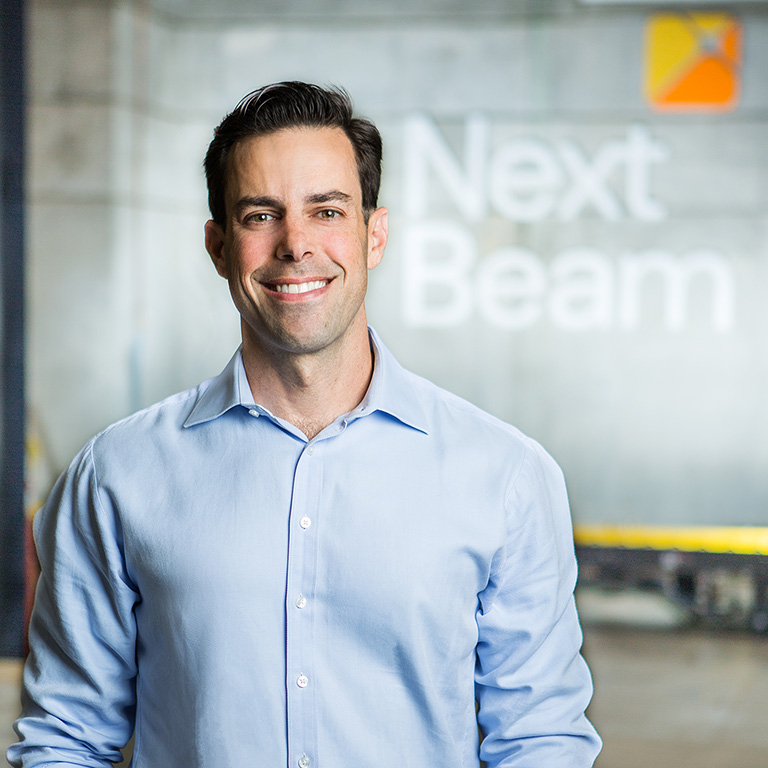
Andrew Patton is an executive and entrepreneur who has held engineering and business leadership roles in tech companies and high finance. After extensively researching the US contract irradiation and sterilization industries, Andrew co-founded NextBeam in 2020 with the vision of creating a new irradiator that would closely collaborate with customers to help solve their most challenging irradiation and sterilization problems. He believes that we are in the process of a longterm industry shift towards clean forms of sterilization, like E-Beam, and that there is a tremendous opportunity to help companies optimize their radiation processing activities. Previously, he led business strategy and operations for Wing, Google’s drone delivery company, and worked as an investment banker specializing in M&A transactions before that. Andrew holds degrees in Mechanical and Aerospace Engineering from Princeton University and a Masters of Business Administration from the Stanford Graduate School of Business. When not working on NextBeam Andrew enjoys working on and flying experimental aircraft.
What is NextBeam?
We founded NextBeam to develop sustainable sterilization capacity for the global medical device industry (and others). Like many, we saw the looming problems incumbent on EO and gamma technologies: how 90% of sterilization gets done today. We resolved that there had to be a better way.
What was your professional journey that led you to working for NextBeam?
I’m very much not a medical industry insider – I actually have spent most of my career working in aerospace, most notably at Boeing and Google… very different organizations. However, I am familiar with delivering mission-critical products in highly regulated fields, as well as the “move fast and break things” approach that gets quoted in Silicon Valley. The trick is in how you adopt elements from each of these approaches at the appropriate time.
Can you share some things your organization has done that you are most proud of?
I think we might have a world record for the shortest time from contract signing to the first commercial business on an E-Beam plant (all in the COVID supply chain winter). Similarly, I am proud of how fast and well we achieved ISO certification, won large customers, etc… but I am by far the most proud of our team. They help define the future of sterilization every day and knock down countless problems and challenges.
What motivates you as a leader?
Growing our team into a cohesive, world-class group and partnering to succeed with teams at our customers across the country is very motivating. It’s always inspiring and energizing to see people come together to make advancements that we didn’t think were possible.
What advice would you give to aspiring healthcare leaders who are looking to make an impact in this industry?
Start with the first principles. There will always be a lot of “that will never happen for X reason” that you’ll hear from industry leaders and experts. It’s important to have a non-consensus view: remember that if it were obvious and everyone agreed, there would already be a huge existing competitor set with no room to innovate!
How do you see the healthcare industry changing in the next 5-10 years, and what is your organization doing to stay ahead of those changes?
I’ll comment on where we focus: the sterilization market. We see the medical device industry “upping its game” and considering sterilization earlier in the product development process. This, in turn, will enable movement away from legacy modalities, such as EO and gamma, and the adoption of E-Beam and new chemical sterilant technologies that are more sustainable and offer a more robust supply chain solution (we are already forgetting so much of the pain that COVID caused from a supply chain perspective!)
How does your company prioritize diversity, equity and inclusion, both in terms of your workforce and the services you offer?
We prioritize inclusion: early on, we took time with the entire team to deep dive into company values and memorialize them at a large scale (you have to see it in person) in our facility. One of the biggest things that emerged from that work was a basis for how we treat each other and what we “owe” each other as good teammates – part of that is respecting each other’s input and opinion, and we have regular monthly meetings where we listen to the team on how they think we can evolve and improve.
What do you see as the biggest opportunity and challenge facing the healthcare industry in Medical Alley?
We think there’s a significant opportunity to extend the network well beyond the Minneapolis-St. Paul area (NextBeam is part of that!).
What are your hobbies or things you enjoy doing when not at work?
Between NextBeam and having 3 kids under 4, there is not a lot of free time! But I grew up flying humble little airplanes and still love to do that.
What is your favorite thing about the Medical Alley community?
There is just an unbelievable treasure trove of R&D, manufacturing, business knowledge, and opportunity across the Medical Alley community in the Midwest. The more and more I learn the more impressed I am with the member companies and humbled/inspired by the work that they do. This is why our American economy is so great: it is the product of a great many teams solving worthy problems (most of which you’ve never heard of), all of which are important in delivering the outcomes that we all too often take for granted as modern consumers.
